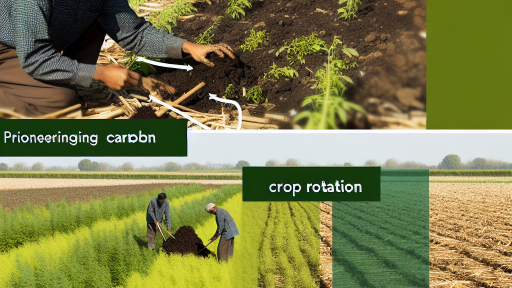Introduction to Cover Cropping and Its Importance in Agriculture
Cover cropping is a vital practice in modern agriculture.
This technique involves planting crops specifically to cover the soil.
It plays a critical role in enhancing soil health and water retention.
Farmers utilize cover crops to combat soil erosion effectively.
Additionally, cover crops reduce nutrient runoff into water systems.
They contribute to improved water efficiency in various ways.
Moreover, this practice supports sustainable agricultural methods.
Benefits of Cover Cropping for Water Efficiency
Cover crops improve soil structure and porosity.
As a result, they enhance the soil’s ability to retain moisture.
This leads to reduced irrigation requirements during dry periods.
Furthermore, deep-rooted cover crops help to break up compacted soil.
This promotes better infiltration of rainwater into the ground.
Reducing Water Runoff
Cover crops play a crucial role in preventing water runoff.
They act as a barrier that slows down rainfall impact.
Thus, they help in filtering excess nutrients before they reach waterways.
Transform Your Agribusiness
Unlock your farm's potential with expert advice tailored to your needs. Get actionable steps that drive real results.
Get StartedAdditionally, they reduce the potential for flooding during heavy rains.
Encouraging Microbial Activity
Increased organic matter from cover crops fosters microbial growth.
These microbes enhance soil health and nutrient availability.
This improved health further supports water retention capabilities.
Healthy soil retains moisture more effectively compared to depleted soil.
Supporting Crop Diversity and Resilience
Planting diverse cover crops enhances biodiversity on farms.
This diversity contributes to a more resilient agricultural ecosystem.
As a result, farms can adapt better to changing climatic conditions.
Diverse root systems ensure that water is utilized efficiently across the field.
Cover cropping is a beneficial practice that enhances water efficiency.
Overview of Water Efficiency in Farming Practices
Water efficiency plays a critical role in contemporary farming practices.
Farmers increasingly recognize the necessity to manage this vital resource wisely.
Efficient water use promotes sustainable agriculture and helps conserve natural ecosystems.
Moreover, it directly influences crop yields and farm profitability.
The Importance of Water Management
Effective water management practices enhance soil health and productivity.
These practices aim to minimize water waste while maximizing crop benefits.
Farmers employ various techniques to achieve these goals.
For instance, implementing drip irrigation systems can optimize water delivery.
Additionally, rainwater harvesting offers an alternative water source.
Strategies for Improving Water Efficiency
Farmers can adopt several strategies to enhance water efficiency.
- Utilizing moisture sensors ensures timely irrigation.
- Cover cropping helps retain soil moisture and reduces erosion.
- Crop rotation diversifies plant water needs, improving overall efficiency.
These techniques collectively foster a more resilient farming system.
Benefits of Enhanced Water Efficiency
Improving water efficiency yields multiple benefits for farmers.
First, it significantly reduces irrigation costs over time.
Additionally, it mitigates the risk of drought impacts on crop production.
Showcase Your Farming Business
Publish your professional farming services profile on our blog for a one-time fee of $200 and reach a dedicated audience of farmers and agribusiness owners.
Publish Your ProfileFurther, it contributes to environmental conservation efforts.
Challenges in Water Efficiency Implementation
Despite its advantages, implementing water-efficient practices poses challenges.
Access to technology and resources can be limited for some farmers.
Moreover, knowledge gaps about effective techniques can hinder progress.
Addressing these challenges is essential for broad adoption.
The Role of Education and Support
Education plays a vital role in promoting water-efficient practices.
Farmers benefit from workshops and training sessions on water management.
Moreover, support from agricultural organizations can provide valuable resources.
Collaboration among farmers, experts, and government is crucial for success.
How Cover Crops Improve Soil Structure and Infiltration Rates
Enhancing Soil Structure
Cover crops play a significant role in improving soil structure.
They create a network of roots that penetrate the soil.
This root system loosens compacted soils effectively.
Consequently, the soil becomes more aerated and porous.
Furthermore, enhanced soil structure boosts the availability of nutrients.
As a result, plants access water more efficiently.
Increasing Infiltration Rates
Infiltration rate is crucial for water management in agriculture.
Cover crops help increase this rate significantly.
They reduce surface runoff by decreasing soil compaction.
This action allows water to permeate deeper into the soil.
Moreover, improved infiltration leads to better groundwater recharge.
Consequently, farmers can rely less on irrigation systems.
Supporting Soil Microbial Life
Cover crops support diverse microbial communities within the soil.
These microbes play essential roles in nutrient cycling.
Healthy microbial life also enhances soil structure over time.
Increased microbial activity promotes greater porosity.
This ultimately leads to improved water retention and availability.
Preventing Soil Erosion
Soil erosion is a significant issue for many farmers.
Cover crops help prevent this erosion effectively.
The roots of cover crops hold the soil in place.
Therefore, they reduce topsoil loss during heavy rains.
This preservation of topsoil maintains soil fertility.
Benefits of Cover Cropping in Agriculture
The benefits of cover cropping extend beyond water efficiency.
They enhance soil structure, increase infiltration rates, and support microbial life.
This leads to healthier soils and more resilient crops.
Delve into the Subject: Reducing Pesticide Use with Integrated Pest Management
The Role of Cover Crops in Reducing Soil Erosion and Water Runoff
Understanding Soil Erosion
Soyl erosion occurs when soil particles are displaced by wind or water.
This process can lead to significant loss of fertile topsoil.
Consequently, farmers face reduced crop yields over time.
Therefore, addressing soil erosion is crucial for sustainable agriculture.
How Cover Crops Mitigate Erosion
Cover crops provide ground cover that protects soil from erosion.
Showcase Your Farming Business
Publish your professional farming services profile on our blog for a one-time fee of $200 and reach a dedicated audience of farmers and agribusiness owners.
Publish Your ProfileThey shield the soil from heavy raindrops that can dislodge particles.
Additionally, their root systems help anchor the soil in place.
Thus, cover crops play a vital role in maintaining soil integrity.
Water Management Benefits
Cover crops improve water infiltration rates in the soil.
This leads to better moisture retention for crops during dry periods.
Moreover, they help reduce surface runoff, promoting better water quality.
As a result, cover crops support overall water efficiency in farming systems.
Reductions in Runoff
Runoff significantly contributes to soil degradation and water pollution.
Cover crops absorb excess rainwater, thereby decreasing runoff levels.
This absorption minimizes the transport of harmful sediments and nutrients.
Consequently, they contribute to healthier ecosystems and cleaner waterways.
Long-Term Soil Health
Beyond immediate erosion control, cover crops enhance soil health over time.
They increase organic matter and microbial activity in the soil.
As a result, farmers can enjoy improved soil structure and fertility.
This, in turn, supports sustainable farming practices for future generations.
Learn More: Sustainable Pest Control with IPM Practices
Enhancing Water Retention through Organic Matter from Cover Crops
Understanding Organic Matter
Organic matter plays a crucial role in soil health.
It enhances the soil’s ability to retain water effectively.
Moreover, organic matter improves nutrient availability.
This leads to healthier crops and better yields.
The Role of Cover Crops
Cover crops contribute significantly to soil organic matter.
They decompose over time, enriching the soil.
This process fosters improved water retention.
Additionally, cover crops reduce erosion risk.
Mechanisms of Water Retention
Cover crops enhance soil structure through root systems.
Their extensive root networks create pores in the soil.
These pores help retain moisture during dry spells.
Furthermore, decaying cover crops increase soil aggregation.
Specific Benefits of Enhanced Water Retention
Improved water retention allows for more efficient irrigation.
This reduces dependency on external water sources.
Farmers experience lower costs and increased resilience.
Additionally, healthier soil leads to better crop performance.
Implementing Cover Crops
Choosing the right cover crop is essential.
Options like clover and rye are popular for water retention.
Farmers should assess local conditions before selection.
Monitoring soil moisture levels can guide decisions.
See Related Content: Conservation Tillage Explained For Sustainable Farming

The Impact of Cover Cropping on Water Quality and Reducing Contaminants
Improving Soil Health
Cover cropping enhances soil health significantly.
This practice increases organic matter in the soil.
Furthermore, it promotes better soil structure.
Showcase Your Farming Business
Publish your professional farming services profile on our blog for a one-time fee of $200 and reach a dedicated audience of farmers and agribusiness owners.
Publish Your ProfileA healthier soil manages water more effectively.
It can hold moisture and nutrients better.
Reducing Soil Erosion
One major benefit of cover cropping is its ability to reduce soil erosion.
Cover crops protect the soil surface from rainfall impact.
They create a protective layer that prevents runoff.
This leads to less sedimentation in water bodies.
Consequently, it helps maintain cleaner waterways.
Filtering Contaminants
Cover crops act as natural filters for harmful contaminants.
They absorb excess nutrients such as nitrogen and phosphorus.
This prevents these chemicals from entering aquatic systems.
Through root systems, they can trap pesticide residues as well.
Thus, cover cropping effectively mitigates water pollution.
Enhancing Water Retention
Cover crops significantly enhance water retention in the soil.
They improve infiltration rates, allowing more water to percolate.
Consequently, more rainwater is available for plants during dry periods.
This reduces the need for supplemental irrigation.
Farmers can efficiently manage their water resources.
Promoting Biodiversity
Cover cropping encourages agricultural biodiversity.
Diverse plant species can inhabit the same field.
This rich biodiversity supports healthy ecosystems.
Moreover, it attracts beneficial insects that help control pests.
Ultimately, this interconnectedness boosts the agricultural system’s resilience.
Delve into the Subject: Efficient Water Management Practices in Agriculture
Case Studies: Successful Implementation of Cover Crops for Water Efficiency
Farmers Overcoming Water Scarcity
In California, the Martinez family faced severe drought conditions.
They adopted cover cropping to improve water retention in their soil.
As a result, their corn yields increased by 15% despite lower rainfall.
This success inspired neighboring farms to implement similar practices.
Enhancing Soil Health in the Midwest
The Thompson Farm in Illinois switched to a diverse cover crop mix.
This decision significantly improved soil structure and moisture retention.
Consequently, their soybean crops thrived even in dry seasons.
Moreover, cover crops reduced erosion during heavy rains.
Research Findings from Agricultural Institutes
A study conducted by the National Institute of Food and Agriculture focused on cover crops.
It highlighted improvements in water efficiency across various crops.
The research demonstrated that utilizing cover crops cut down water usage by 20%.
Additionally, it noted enhanced nutrient availability for crops.
Community Initiatives Promoting Water Efficiency
The EcoFarm Initiative connects farmers striving for sustainability.
Through workshops, they teach cover cropping techniques effectively.
These community efforts have led to a noticeable increase in local water conservation.
Farmers report healthier crops and better yields as a result.
Future Directions and Innovations
Emerging technology aims to optimize cover cropping strategies further.
Showcase Your Farming Business
Publish your professional farming services profile on our blog for a one-time fee of $200 and reach a dedicated audience of farmers and agribusiness owners.
Publish Your ProfileInnovative tools now assess soil moisture levels more accurately.
Such advancements will enhance the potential benefits of cover crops.
As research continues, we can expect even greater water efficiency gains in agriculture.
Challenges and Considerations When Implementing Cover Cropping Systems
Initial Setup Costs
Implementing cover cropping systems can require significant upfront investment.
Farmers need to consider costs for seeds, equipment, and labor.
Budget constraints may limit implementation for some growers.
Nevertheless, long-term benefits often outweigh these initial costs.
Selection of Suitable Cover Crops
Choosing the right cover crop for specific conditions can be challenging.
Different crops provide varying benefits for soil and water retention.
Farmers must assess soil type, climate, and agronomic goals.
Research and expert consultations can aid in the selection process.
Management Practices
Effective management practices are crucial for successful cover cropping.
Farmers must monitor crop growth and incorporate them effectively.
Additionally, they need to plan for termination of cover crops.
Failure to manage could lead to competition with cash crops.
Pest and Disease Issues
Cover crops can sometimes harbor pests and diseases.
Farmers need to be vigilant and monitor for potential threats.
Integrated pest management strategies can mitigate these risks.
Awareness of local pest dynamics is essential for success.
Potential Impact on Cash Crops
Using cover crops can affect the growth of subsequent cash crops.
While they improve soil health, they may also compete for nutrients.
Careful planning can minimize negative impacts on yields.
Farmers should evaluate their overall crop rotation plan.
Training and Education
Farmers may require additional training to implement cover cropping effectively.
Workshops and field days can enhance understanding and skills.
Access to resources and continuing education is vital.
Networking with other farmers can also provide valuable insights.
Additional Resources
Cover Crop Trends, Programs, and Practices in the United States
Water Conservation in Agriculture – Nevada Irrigation District




